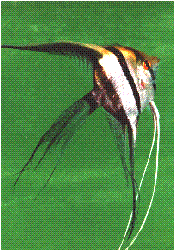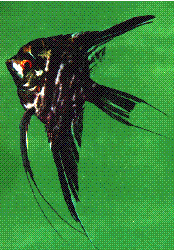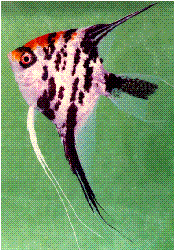Individual Fish Description Page


This page will give a completely detailed profile of the
selected fish, from A to Z. The profiled fish will be
chosen randomly by Badman, and will come from the complete
genre of tropical fish. I will try to up-date the profile
on a monthly basis. If you have a specific fish you want
profiled please
E-MAIL
ME
and I will try to fill your request.



Silver Angel
|

Marble Angel
|

Koi Angel
|
Pterophyllum Scalare
Classification
- Order: Perciformes
- Sub-order: Percoidei
- Family: Cichlidae
- Genera: Pterophyllum
Common name
Angelfish, Scalare
Distribution
Amazon and some of its tributaries, like the Tapajoz.
General Body Form
Disk-shaped. Dorsal and Anal fins Are elongated and sail-like, the Pectoral fins are stretched into long filaments. The Caudal fin is fan shaped and broad. The outermost fin rays are prolonged. In older fish the forehead bulges. Including the fins the Angel may reach a length of six inches and a height of ten inches.
Coloration
The body is Silvery with a slight Brown tinge, the snout, back and forehead are Brownish Yellow. Sides are marked with four Black transverse bars, the first running in a curve from thhe nape through the eye to the start of the Ventral fin, the second from the Dorsal to the anus, the third is the most prominent runs from the Dorsal to the Anal fins and the fourth crosses the start of the Caudal fin. A few fainter bars can sometimes be seen in the upper half of the body.The Dorsal fin spines are Yellow-Brown, the front of the Ventral fins Steel-Blue and the soft rayed parts of the unpaired fins are Grayish-White.
The above paragraph was a description of the original wild caught specimens and is seldom seen in its true colors anymore. Today Angels come in all color varieties and more are added almost everyday. There are Black, Gold, Ghost, Marble, Veiltail and many more available today. All are the result of color and fin mutations through selective breeding.
Maintenance
They should be kept in a fairly large and tall aquarium, with plants that reach from the substrate to the water surface. Angels prefer to live among the plants. There should also be an open area for swimming. The water temperature should be kept at least at 72o, but preferably higher. The hardness of the water is not overly important, but as with all fish the, you must do your water changes. Angels are not fussy eaters and will accept flake and frozen food and relish live foods of all kinds including small Crustaceans and Tubifex worms. Angelfish should be kept in small schools and purchased small, not as older specimens. As an aquarium inhabitant Angelfish have several good points, A striking body form,elegant swimming patterns, usually peaceful with all but the smallest fish, they do not dig up the substrate or destroy the plants and they prefer to swim in the middle layers of the tank. An all around winner for any aquarium.
Breeding
A group of young Angels should be placed in the aquarium and allowed to mature together. Some Specimens will pair off and remain faithful to each other for many years. They are typical open breeders and both parents take part in brood protection, guarding and fanning the eggs and site location. the temperature should be raised to 79 to 86 and the eggs will hatch in a day or so. The parents will help the fry by "chewing" them out of the egg membrane and spitting them onto the leaves, where they hang by short filaments.The fry will be moved to shallow pits dug in the substrate. After four or five days the fry become free swimming and the whole school will start to hunt for food. At this time the parents will keep all other fish away from their young. The fry need fine food like baby brine shrimp or crushed flake food. Brood protection continues for a long time.
Angelfish breeding has been covered to a large degree by other sites and I have only put the bare bones facts here. for a more complete description of anglefish breeding I am including a couple of links that cater specifically to the Angel.


to fish profiles

Email:
badman2nd@hotmail.com





